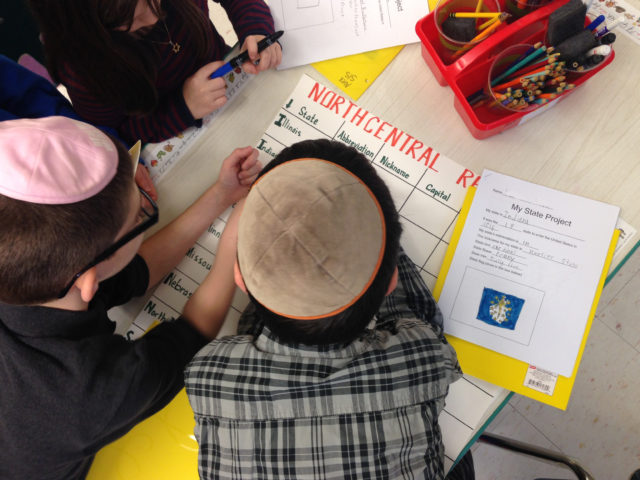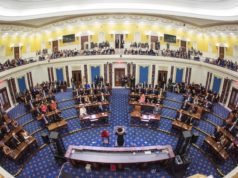Due to the longstanding attachment that most non-Orthodox American Jews have had to public education, the institutions representing them have long opposed “education choice” policies, such as school vouchers and K-12 education savings accounts, that allow public funds to follow the child to the school of his or her family’s choice. It is time to rethink that attachment. Private schools have proven better than public schools at instilling the type of civic virtues that are essential to the flourishing of religious and ethnic minorities, like Jews, within a representative democracy. As radicals attempt to indoctrinate children with anti-Israel and even anti-Semitic beliefs, educational choice policies are necessary not only to provide educational alternatives, but also to empower families fighting to keep such odious views out of the public education system.
The notion of significant structural reform to the American K-12 education system is often met with resistance in many quarters of the American Jewish community. For one, public education is conventionally regarded as the crucible through which Jews became Americans. Moreover, the traditional public education system has worked well for American Jewry. In popular imagination, public schools fueled rapid Jewish social mobility, both by conveying the knowledge and skills required to succeed in the labor market and employing a significant number of Jews as educators. Finally, just as many American Jews long believed that public schools helped the community make the adjustment from shtetl to suburb, they also tend to believe that they train individuals from diverse backgrounds to embrace liberal democratic norms, such as respect for religious and ethnic diversity. In other words, the same public schools that taught American Jews to become good neighbors also taught our neighbors to be kind to the Jews.
For these reasons, the notion of expanding education choice policies does not necessarily elicit great enthusiasm from the Jewish community. In fact, the anti-Defamation League explicitly opposes school vouchers, their opposition predicated in part on the concern that “under voucher and neo-voucher programs, our educational system and our country would become even more Balkanized than today.” Likewise, the Reform movement’s Religious Action Center lists a litany of reasons they oppose school choice policies, including that they supposedly “threaten the First Amendment’s guarantee of religious liberty” and “divert desperately needed resources away from the public school system and help only a few of the nation’s children.”
The ADL and RAC position does not hold up to scrutiny. A 2007 review of the research literature found that private schools typically outperform public schools in instilling civic values such as political tolerance and voluntarism. Two studies published since then only reinforce the private school advantage, especially as it relates to the welfare of American Jews. A 2017 study co-authored by one of us concluded that private school-educated adults were less likely to profess belief in anti-Semitic stereotypes, even after controlling for a variety of background characteristics. Another 2017 study meanwhile found that among the seven jihadist homegrown U.S. terrorists for whom the researchers could find education records, none of them attended Islamic schools.
Scholars do not agree about why private schools outperform public schools in preparing Americans for virtuous democratic citizenship. In the study about the education origins of homegrown Islamic terrorists, researchers posit that Islamic schools give students a sense of purpose, the absence of which is linked to subscription to extremist ideologies. In the aforementioned study about education background and anti-Semitism, the authors postulate that “our answer might rest in the critical self-examination that Christian, particularly Catholic, organizations undertook after the Holocaust… The greater tolerance of Jews observed at private schools – the overwhelming majority of which are affiliated with religious organizations – might simply reflect contemporary church teachings.” Other studies linking private schools to positive civic outcomes stress the importance of an open classroom climate: Private school teachers are willing to engage students in controversial topics (e.g. Holocaust denialism) that public school teachers are trained to avoid.
Whatever the reason, a pluralistic education system better meets the needs of a pluralistic polity. That relative advantage might say as much about the failure of public education as it does the success of private education.
The Growing Threat of Anti-Semitic Ideology in Public Education
Anti-Semitism is on the rise in America’s schools. According to a study by the ADL, hate incidents directed at Jews quadrupled in K-12 schools from 2015 to 2017. Indeed, the ADL found that “in 2017, K-12 schools surpassed public areas [such as parks and streets] as the locations with the most anti-Semitic incidents.”
Worse still, there are indications that the U.S. public education system itself sometimes contributes to the problem. Reviews of popular American textbooks concluded that “information concerning Jews and Israel is fraught with half-truths, double standards, and outright lies.” For example, several textbooks erroneously characterize the Second Intifada as a spontaneous uprising. One textbook falsely claims that Israel placed Palestinians in refugee camps, while several that cover the Arab-Israeli conflict omit mention of the migration of Jewish refugees from Arab nations around the time of the founding of the modern state of Israel.
While anti-Jewish pedagogy is nothing new, there are some indications that the phenomenon is becoming more acute and widespread. As the recent publication of the 1619 Project highlighted, culture warriors are increasingly less willing to allow facts to get in the way of self-affirming narratives.
Postmodern, “woke” sensibilities were clearly reflected in the first draft of California’s controversial ethnic studies curriculum, which omitted the Jewish-American immigrant experience and championed the Boycott, Divestment, Sanction (BDS) movement as a “global social movement that currently aims to establish freedom for Palestinians living under apartheid conditions.“ Moreover, the curriculum identified “classism, homophobia, Islamophobia, and transphobia” as types of oppression, but omitted anti-Semitism. In fact, American Jews were initially not even mentioned as a minority group. After a wave of criticism, a third version included two lessons on American Jews – one which taught “that Mizrahi Jews coming to the United States from Arab lands were mistreated by ‘white’ Ashkenazim” and another that claimed “that Jews of European descent have white privilege.” In other words, in a curriculum based on a reductive worldview that categorizes racial and ethnic groups as oppressor and oppressed, Jews were portrayed primarily as oppressors.
Given local control of public schools, anti-Jewish woke pedagogy is more likely to take root in California districts before it does, say, in Texas districts. Still, the phenomenon is not confined to the West Coast, and it draws support from national teacher unions. Worryingly, in recent years, the national teachers’ unions have cozied up to far-left radicals. For example, American Federation of Teachers President Randi Weingarten called former Women’s March leaders Tamika Mallory and Linda Sarsour “friends” and “warriors for justice.” Mallory accused Jews of “upholding white supremacy” in an “apology” for accusations of even more grotesque remarks, while Sarsour has praised Palestinian terrorism as “the definition of courage.”
Reversing the rising tide of anti-Semitism in America’s K-12 education system will require bold new policies that shift the locus of control away from bureaucrats and special interests and toward families.
Education Choice: Exit and Voice
A half-century ago, economist Albert O. Hirschman described two ways that members of an organization can cope with a decline in the quality of the service or benefits the organization provides: exit or voice. They can speak up and try to influence the organization from within or they can simply leave. Public schools, alas, tend not to be particularly responsive to either exit or voice. This is particularly true in lower-income areas where parents cannot afford either to move to a better district or pay for private school. In such cases, the public schools are a monopoly with a captive audience. Those who have no choice will also have difficulty exercising their voice.
Education choice policies break that monopoly. By allowing public funds to follow the child to the learning environment that parents choose, school choice policies provide families with an exit option. If families are unhappy that the public school system has become politicized, choice policies provide an immediate escape hatch.
Indeed, universal choice policies have the potential to fundamentally transform the U.S. education system. When asked what type of school they would choose if cost were not a factor, only 35 percent of parents of K-12 students said they would prefer a public school, compared to 40 percent who would choose a private school. This differs dramatically from actual enrollments. At present, about 83 percent of U.S. students attend a traditional public school while only eight percent attend private school. Even if nothing else changes, choice policies would mean far fewer children being exposed to anti-Semitic curricular materials. If so, dayenu, that would be enough. Therefore, we should be even more grateful that education choice policies also have the potential to affect what goes on in the public schools.
Although Hirschman himself was initially skeptical of the use of the exit option in a public education setting, he eventually reversed himself, concluding that “opening up of previously unavailable opportunities of choice or exit may generate feelings of empowerment in parents, who as a result may be more ready than before to participate in school affairs and to speak out.” In other words, parents are more likely to speak up when they have other options–and the school administrators know it.
Education Choice in America Today
More families are exercising education choice than ever before. When Nobel Laureate economist Milton Friedman founded the Friedman Foundation for Educational Choice (now called EdChoice) in 1996, only a handful of states had school vouchers or individual-use tax credits or deductions for private education expenses. Twenty-five years later, there are 67 choice policies–also including K-12 education savings accounts and tax-credit scholarships–serving more than 600,000 kids in 29 states plus Washington, D.C. and Puerto Rico.
Participating families are highly satisfied. In a survey of parents of students using Florida’s tax-credit scholarship program – the largest choice program in the nation – more than nine in ten expressed satisfaction with both the program and the school their child attends using the scholarships. More than two dozen other parental satisfaction surveys also find that families are overwhelmingly satisfied with the education their children receive using education choice programs.
The growth in education choice over the last quarter-century has been impressive, but there’s still a long way to go. Most programs limit participation via restrictive caps or by limiting eligibility to special needs and other disadvantaged students. Only in Arizona and Florida are five percent or more of K-12 students utilizing a choice program to access a private school or to homeschool, and only nine additional states plus Washington, D.C. top one percent.
The education choice movement may be hitting a tipping point, however. As of March 2021, more than 30 states are considering legislation to create new education choice policies or to expand existing ones. The movement has the potential to top its high-water mark when the Wall Street Journal declared 2011 “the Year of School Choice” after 13 states enacted new choice policies or expanded existing ones. It’s not just the quantity of bills – it’s also the quality. Instead of traditional vouchers, which can be used at private schools, more than a dozen states are considering K-12 education savings accounts that can also be used for tutoring, textbooks, homeschool curricula, online courses, educational therapy, and more. Legislators are going bolder with more expansive policies, including potentially universal eligibility for education savings accounts in New Hampshire and West Virginia.
Legislative interest in enacting choice policies follows a spike in enthusiasm among parents. According to polling by EdChoice, support for education savings accounts hit 80 percent among parents of K-12 students in February 2021, up more than 20 percentage points since 2016. Support was even higher among parents who were black (81 percent), Hispanic (83 percent) and Asian (87 percent).
Much of the recent enthusiasm for choice policies stems from the COVID-19 pandemic – and especially the public school establishment’s response to it. Parents quickly came to realize that their diverse needs could not be met by a single institution. When schools closed and shifted to distance learning, some kids thrived but most foundered. A report from McKinsey in December 2020 found that on average, students “lost the equivalent of three months of learning in mathematics and one-and-a-half months of learning in reading.” Learning losses were even greater among students of color.
Yet when parents – exhausted from trying to manage their children’s Zoom school schedule while they also worked from home – demanded that public schools re-open as the private schools down the street managed to do safely, they had a rude awakening: public schools were not directly accountable to them. Instead, the schools were beholden to special interests – particularly teachers unions – that wanted to keep the schools closed. And so, in most cases, closed they remained. A survey by Education Next in the fall of 2020 found that only 24 percent of public school parents said their schools were open for in-person instruction compared to 60 percent of private school parents. Not surprisingly, the same survey found that private school parents were more than twice as likely as public school parents to report being “very satisfied” with their school’s performance during COVID (55 percent to 25 percent).
Whether 2021 becomes the “Year of Education Choice” remains to be seen. More and better bills are advancing, but entrenched special interests are doing everything in their power to stop the momentum. To successfully enact education choice policies, families will have to flex their civic muscles and show policymakers that they care deeply about the issue, and that they will hold legislators accountable for their votes.
Ian Kingsbury is an Education Fellow at the Empire Center for Public Policy. Jason Bedrick is Director of Policy at EdChoice.






